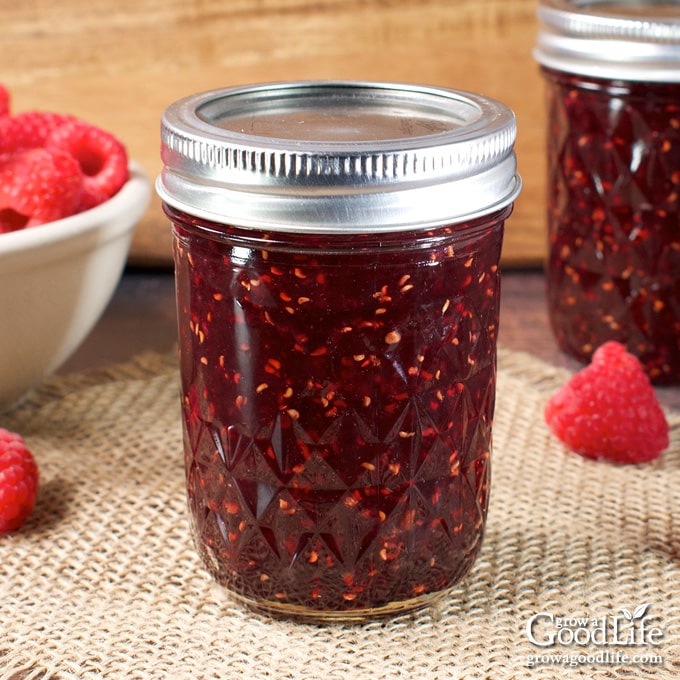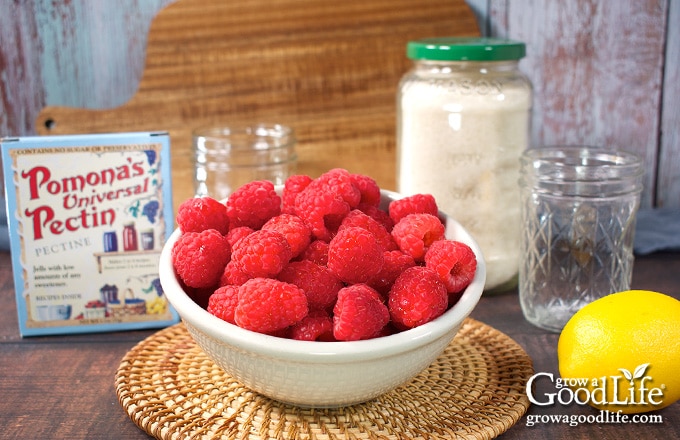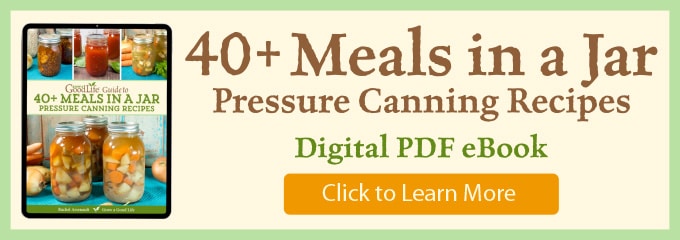Low Sugar Raspberry Jam Recipe
This post may contain affiliate links, which means that I may receive a commission if you make a purchase using these links. As an Amazon Associate I earn from qualifying purchases.
Preserve the vibrant flavors of fresh raspberries with our low sugar raspberry jam recipe. This canning recipe ensures a long-lasting supply of homemade goodness. Spread it on toast or gift a jar to loved ones!
If you’re looking for a healthier and more balanced option for your homemade jam, you’ve come to the right place. This recipe allows you to enjoy the vibrant flavor of raspberries while reducing the amount of sugar used.

We started our raspberry patch from just six bare root canes about 15 years ago, and every year it produces gallons and gallons of fruit. We eat what we can, freeze some for later, and I turn the abundance into raspberry jam. This jam is our favorite. It uses less sugar, letting the full flavor of raspberry shine.
Get ready to savor the pure taste of raspberries with this low sugar jam, perfect for spreading on toast, swirling in yogurt, or adding a fruity touch to your favorite recipes. Let’s dive in and discover how to make this delightful and guilt-free treat!

About the Ingredients
Before we begin, let’s go over the key ingredients. From choosing ripe raspberries to the versatility of sweeteners and the unique properties of Pomona’s Universal Pectin, let’s explore how these ingredients combine to create a delicious homemade jam.

Raspberries
When making raspberry jam, you can use different varieties of raspberries depending on your preference and availability. Here are some common types of raspberries that are suitable for making jam:
- Red raspberries are the most common and widely available variety for making jam. They have a vibrant red color and a balanced sweet-tart flavor, perfect for creating delicious jams.
- Black raspberries have a dark purple or black color and a rich, sweet flavor. They are less common than red raspberries but can create a unique and flavorful jam with a hint of tartness.
- Golden raspberries have a beautiful yellow color and a milder, sweeter flavor compared to red raspberries. They can be used to make a jam with a delicate and subtly sweet taste.
- Purple raspberries are a hybrid variety that combines the characteristics of red and black raspberries. They have a unique flavor profile with a slightly tart taste and a hint of sweetness.
Regardless of your variety, make sure to select ripe, plump raspberries free from mold or insect damage. The overall flavor of the jam will greatly depend on the raspberries’ quality.
You can also use frozen raspberries for this recipe. Remove the raspberries from the freezer, thaw them in the fridge overnight, and then measure 4 cups of thawed berries, including any liquid released during thawing.
Pomona’s Universal Pectin
This recipe calls for Pomona’s Universal Pectin, a citrus pectin that offers several advantages over typical boxed pectin. Unlike regular pectin, Pomona’s Universal Pectin uses calcium powder to gel instead of relying on large amounts of sugar and extensively high cooking temperatures that may diminish the fruit’s flavor. This lets the natural fruit flavor shine through in your jellies and jams rather than the overwhelming sweetness of sugar.
Sweeteners
While this recipe includes a specified amount of sugar, Pomona’s Universal Pectin provides flexibility when it comes to sweetening options. You can adjust the sweetness according to your preference and use up to 2 cups of sugar if you like a sweet jam. After dissolving the pectin, taste the mixture and add more sugar if needed, then boil for an additional minute while stirring to dissolve the sugar.
You can also use alternative sweeteners. Consider substituting 1/2 to 1 cup of mild-flavored honey to create honey-sweetened raspberry jam. You also have the freedom to explore other sweeteners that measure similarly to sugar or honey. Liquid sweeteners like agave or maple syrup can be viable options as well.
Lemon Juice
Adding lemon juice to the raspberry jam is optional for this recipe but highly recommended. Lemon juice enhances the flavor of the jam and helps preserve its vibrant color. You can use either fresh or bottled lemon juice. You can even use lemon zest for additional flavor.
How to Make Raspberry Jam
For those new to canning or seeking a refresher on the process, I recommend reviewing the water bath canning tutorial provided on the National Center for Home Food Preservation website.
You can find the full printable recipe at the end of this post, but here are the detailed steps for making and home-canning raspberry jam.
Step 1: Gather Your Kitchen Gear
Before you begin, take a moment to gather the following essential items:
- A water bath canner with a canning rack
- 5 half-pint canning jars
- Canning lids and bands (lids should be new, while bands can be reused)
- Canning tools: jar lifter, canning ladle, funnel, and bubble popper
- A small clear jar with a lid for the calcium water mixture
- Basic kitchen supplies: a medium saucepot (6 to 8 quarts), prep bowls, measuring cups and spoons, a potato masher, a large spoon, and plenty of clean kitchen towels
No Water Bath Canner? If you don’t have a dedicated boiling-water canner, you can still achieve excellent results using a large saucepot. Just make sure the pot is tall enough to fully cover the tops of the jars by a few inches, with ample space (at least two inches) to prevent boiling water from splashing out. To protect the jars from direct heat, place a rack at the bottom of the pot to elevate them, ensuring they remain intact throughout the canning process.
Step 2: Prepare the Canning Equipment
Wash the jars, lids, screw bands, and canning tools thoroughly with warm, soapy water. Check over the jars carefully and remove any cracked, scratched, or nicks in the rims. Rinse everything well and set aside to dry.
Place the water bath canner on a large burner of your stove. Add the canning rack to the bottom, then arrange the clean jars upright on the rack.
Fill the pot with water so that the jars are fully submerged. Heat the canner to a simmer at around 180˚F (82˚C), and warm the jars for at least 10 minutes. Keep the jars warm until you’re ready to fill them.
Step 3: Prepare the Ingredients
Inside the package of Pomona’s pectin, you will find two envelopes containing pectin and calcium powder. Follow the steps below to mix the sweetener with sugar, make the calcium water, and prepare the raspberries:
Mix Pectin and Sweetener
To prepare the pectin, add the sugar, or preferred sweetener, to a small bowl. Measure 2 teaspoons of the pectin powder, add it to the sugar, and stir well to ensure it is evenly distributed and thoroughly mixed with the sweetener. Reserve the remaining pectin for future recipes.

Make the Calcium Water
Add 1/2 cup of water to a clean jar with a secure lid. Then, add 1/2 teaspoon of calcium powder to the jar. Secure the cover tightly on the jar and shake it vigorously. You will only need 2 teaspoons of calcium water for this recipe. Store the remaining calcium water in the refrigerator for future use in making other jams and jellies. Be sure to label the jar for easy identification.
Prepare the Raspberries
Remove any stems and rinse the raspberries under clean running water. Use a potato masher or a fork to gently crush the raspberries to release their juices. You can leave some berries partially intact for a chunkier texture or mash them thoroughly for a smoother consistency. Measure 4 cups of the mashed raspberries.
For a Seedless Raspberry Jam: To make raspberry jam without seeds, you can strain the fruit to remove the seeds. First, place the raspberries in a saucepan and heat over low while crushing them using a potato masher or a fork until they become a pulpy consistency.
Then, pour the crushed raspberries into a fine-mesh sieve or a strainer set over a bowl. Use the back of a spoon to press the pulp against the sieve, extracting the pulp and juice while leaving behind the seeds. Continue pressing and scraping until you’ve extracted as much liquid as possible, and only the seeds remain in the sieve. Next, measure 4 cups of the seedless raspberry pulp for this recipe.
Step 4: Make the Jam
In a medium saucepan, combine 4 cups of mashed raspberries, along with lemon juice (if using), and 2 teaspoons of calcium water. Mix well, and bring the mixture to a boil over medium-high heat.
Once the mixture is boiling, add the sugar/pectin mixture to the pot. Stir vigorously to dissolve the sugar and pectin completely. Continue stirring until the jam returns to a full boil, which usually takes about 1 to 2 minutes.
As soon as the jam reaches a full boil, remove the saucepan from the heat to prevent overcooking, and fill your jars.
Step 5: Fill the Jars
Prepare your workspace by spreading a dry kitchen towel on the counter. With the help of a jar lifter, carefully remove a jar from the canner, allowing the water to drain back into the pot. Place the jar on the towel. Keep the other jars in the canner to stay warm.
Fill the jar with raspberry jam using a canning funnel and ladle, leaving approximately 1/4-inch of headspace at the top. This space allows for proper expansion during the canning process.
Run a bubble popper through the jar to release any trapped air bubbles. Take a damp towel and wipe the rim of the jar, ensuring it is clean and free from any residue. A clean rim promotes a secure seal between the lid and the jar.
Center a lid on top of the jar, ensuring it sits flat and aligned. Place a band over the cover and tighten it firmly until it is fingertip-tight. Avoid over tightening, as it may block the escape of air during canning.
Return the filled jar to the canner and repeat the same process with the remaining jars, filling them one by one.
Step 6: Process the Jars in the Water Bath Canner
Once all the jars are filled and back in the canner, adjust the water level to cover them by at least 2 inches.
Bring the canner to a full rolling boil over high heat. Once the canner reaches a vigorous boil, start the timer and process the jars for the recommended processing time specified in the recipe. Maintain a steady boil throughout the processing time to ensure proper heat distribution.
After the processing time is complete, turn off the heat and allow the jars to settle. Then, carefully remove the jars from the canner using the jar lifter and place them on a kitchen towel or cooling rack. Keep the jars upright and avoid touching the lids or tightening the bands. Remember, it takes time for the jars to seal completely. Allow the jars to cool undisturbed for 12 to 24 hours, allowing the sealing process to take place.

Ways to Enjoy Raspberry Jam
Raspberry jam is versatile and can be used in various delicious ways. Here are some suggestions:
- Breakfast Topping: Spread raspberry jam on toast, biscuits, bagels, or English muffins for a delicious breakfast or snack.
- Yogurt Parfait: Layer raspberry jam with yogurt and granola to create a flavorful and healthy parfait.
- PB&J Sandwich: Use raspberry jam as the “J” in a classic peanut butter and jelly sandwich for a tasty twist.
- Swirl in Oatmeal: Add a dollop of raspberry jam to your bowl of oatmeal and swirl it in for a sweet and fruity flavor.
- Gift Idea: If you want to gift raspberry jam, you can package it in a decorative jar with a ribbon or personalized label. Consider pairing it with freshly baked scones, a loaf of homemade bread, or a gift basket of breakfast items. Presenting the jam as part of a breakfast or brunch-themed gift is a thoughtful and delicious gesture.
Low Sugar Raspberry Jam Recipe
Ingredients
- 8 cups whole raspberries
- 1 package Pomona's Universal Pectin
- 1 cup sugar
- 1/2 cup water
- 2 tablespoons lemon juice optional for flavor, freshly squeezed or bottled juice.
Instructions
Prepare the Canning Equipment:
- Thoroughly wash the canning tools, jars, and lids with hot soapy water. Rinse well and allow them to air dry on a clean kitchen towel.
- Place the jar rack in the water bath canner, arrange the jars on the rack, and add enough water to cover the jars.
- Bring the canner to a simmer (180˚F) over medium heat, warm the jars for at least 10 minutes, and then keep them warm until you are ready to fill them.
Prepare the Ingredients:
- Rinse the raspberries under cool running water, removing any stems. Mash the berries and measure 4 cups of mashed raspberries. Set aside.
- In a small bowl, combine the sugar (or honey) and 2 teaspoons of Pomona’s pectin powder. Mix well and set aside.
- Prepare your calcium water by combining 1/2 teaspoon calcium powder (from the small packet in the Pomona’s pectin box) with 1/2 cup water in a jar with a lid. Shake well to mix.
Make the Raspberry Jam:
- In a medium pot, combine the mashed raspberries, 2 teaspoons of the prepared calcium water, and lemon juice if using.
- Place the pot over medium-high heat and bring the mixture to a boil. Once it boils, add the sugar/pectin mixture and stir well to dissolve.
- Continue stirring until the jam returns to a full boil, about 1 to 2 minutes. Then, remove the pot from the heat and fill your jars.
Fill the Jars:
- Spread a kitchen towel on the counter. Using a jar lifter, carefully remove a jar from the canner, allowing the water to drain back into the canner. Place the jar on the towel.
- Use a canning ladle and funnel to fill the jar with jam, leaving 1/4-inch headspace at the top.
- Run a bubble popper through the jar to release any air bubbles, then wipe the rim with a clean, damp towel to remove any sticky residue.
- Add the lid and screw the band on until it is fingertip tight.
- Place the filled jar back into the canner, and repeat this process with each jar.
Process the Jam in a Water Bath Canner:
- Once all the filled jars are in the canner, adjust the water level so it is at least 2 inches above the jar tops.
- Cover the canner and bring it to a vigorous boil over high heat. Once it boils, set a timer and process for 10 minutes for altitudes below 1,000 feet. Adjust processing time according to your altitude if needed (See notes).
- After the processing time is complete, turn off the heat and allow the canner to cool down for about 5 minutes.
- Spread a dry kitchen towel on your work surface. Carefully remove the cover by tilting it away to avoid steam burns.
- Use the jar lifter to remove the jars from the canner and place them on the towel. Keep the jars upright, and don’t tighten bands or check the seals yet. Let sit undisturbed for 12 to 24 hours to cool.
Check Seals and Store:
- Check the jar lids after 12 to 24 hours to ensure they have sealed properly. Press the center of each lid; it should not pop up or flex.
- Refrigerate any jars that didn’t seal properly and consume their contents within 2 weeks.
- Remove the screw-on bands, wash the jars, and label them with the date and contents. Store the sealed jars in a cool, dark place.
- For optimal flavor, use the jam within 12 to 18 months. Once opened, refrigerate and consume within 2 weeks. This recipe will make about 4 to 5 half-pint jars of jam.
Notes
Nutrition
40+ Meals in a Jar Pressure Canning Recipes
In this eBook, you will find 50 pressure canning recipes, including 44 meals, along with homemade stocks and bone broths. Recipes include soups, stews, chilis, beans, beef, pork, and poultry. Explore the world of preserving delicious home-cooked meals for all seasons.


